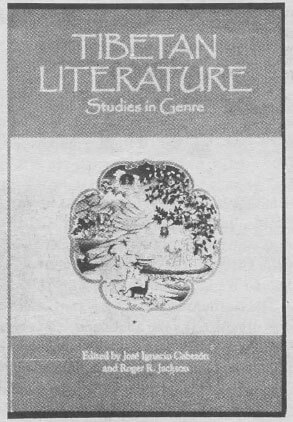| The following article is from the Autumn, 1995 issue of the Snow Lion Newsletter and is for historical reference only. You can see this in context of the original newsletter here. |
Studies in Genre
ed. by Jos Ignac Cabezn and Roger R. Jackson

Essays in honor of Geshe Lhundrup Sopa 530 pp. #TILI $29.95, #TILIC $45 cloth

The following excerpt is taken from the Editors' Introduction to Tibetan Literature.
Tibet possesses a literature that stretches back over 1300 years. It is one of the great literary traditions of Asia, in terms of both its size and range of influence. From ancient pillar inscriptions, to manuscripts sealed away in long-forgotten caves, to block-printed texts on every imagmable subject piled high in monastic libraries, the Tibetan corpus numbers tens of thousands of works. It has exercised an abiding influence not only in Tibet itself, but in the larger cultural area at one time dominated by Tibet, which includes Mongolia, Ladakh, Nepal, Sikkim, Bhutan and parts of northern Pakistan, northern India, western China and southern Russia.
In spite of its size and influence, Tibetan literature was largely unknown to either scholars or the public in the West as recently as thirty-five years ago. This is because the period in which expanding Western colonial powers encountered and began to study Asian literary traditions-the eighteenth and nineteenth centuries-coincided with Tibet's systematic (and virtually unprecedented) isolation from the rest of the world. A few intrepid missionaries, adventurers, soldiers and scholars did make their way to the Roof of the World, and some even reached the Forbidden City, Tibet's capital of Lhasa. The West's first intimations of the richness of Tibetan literature were derived from the reports of such early figures as the Jesuit father Ippolito Desideri (eighteenth century), the Hungarian linguist and explorer Alexander Csoma de Koros (mid-nineteenth century), and the English soldier L. A. Waddell (early twentieth century). Later, in the 1930s and 1940s, the Russian historian A. I. Vostrikov and the Italian scholai' Giuseppe Tucci began to provide the first detailed scholarly accounts of Tibet and its literature. Stili, such accounts were few and far between, and until the 1960s Tibet was fai' less known from its own literature than from its caricatures in Western writing-whether as the inaccessible home of the ascended masters celebrated by Theosophists, the utopian Shangrila of the novel and film Lost Horizon, or the land of psychic mysteries detailed in the autobiographical writings of T. Lobsang Rampa, who claimed to be a Tibetan adept who had transferred his consciousness into the body of an Englishman.
In the last thirty-five years, ali this has changed. Tibetan literature is now better known in the West than ever before. Translations of Tibetan works fili entire shelves ili some Western bookstores, anu courses 011 Tibetan religion and culture have become a fixture, rather than a rarity, at many universities. Like the earlier dearth, the present plethora of information on Tibetan literature is attributable to historical circumstance-in this case, the tragic diaspora of Tibetans that began in 1959. In that fateful year, an abortive revolt against the eight-year occupation of the country by the Chinese led to the flight, to India, of Tibet's spiritual and temporal ruler, the Dalai Lama, who was followed into exile by nearly 100,000 of his compatriots. In the ensuing years, while Tibet itself has suffered terrible depredations at the hands of its occupiers, exiled Tibetans have preserved their culture in small communities throughout India and Nepal and, increasingly, in Europe and America. The dispersal of thousands of Tibetans-many of them deeply learned in their own traditions-coincided with the rise, in the 1960s and 1970s, of a fascination among Westemers, particularly the young, with ali things Asian. First in Nepal and India, and later in the West itself, contacts between Westerners and Tibetans became increasingly common. One of the fruits of this encounter was a quantum leap in the quantity and quality of Western scholar-ship about Tibet.
Despite this increase in Western knowledge of Tibetan literature, its study is stili, relatively speaking, in its infancy-especially in comparison to the work that has been done on the literatures of India, China and Japan. Only a tiny portion of the vast Tibetan coipus has been translated into or discussed in Western languages, and the works that have been translated are overwhflmingly on religious and philosophical subjects. This reflects the fact that the majority of Tibetologists have been motivated, initially at least, by religious curiosity, and this has, unfortunately, helped create the mistaken impression that Tibetan literature is exclusively religious. Granted, religious works in Tibetan are numerous and influential, and liighly valued by educated and simple Tibetans alike, but there is much else in the coipus besides: lyric and epic poetry, at least one novel, and discussions of a wide range of arts and sciences, inciuding grammar, politics, medicine, law, art and architecture, and even erotics. Even among Tibetologists, appreciation of the range and variety of Tibetan literature has grown slowly, and the evidence for it has tended to be published piecemeal, primarily in scholarly aiticles tucked away in obscure joumals or edited volumes. It is a centrai purpose of this volume to help remedy this situation by bringing together under a single cover a series of essays that will convey at least a sampling of the tremendous range of genres actually represented in Tibetan literature, and convey, too, a sense of our present knowledge of these genres. ?

